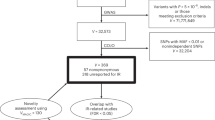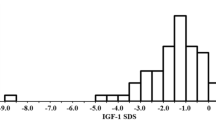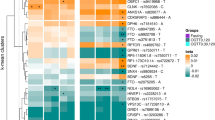Abstract
Interindividual variation of the IGF2-INS-TH region influences risk of a variety of diseases and complex traits. Previous studies identified a haplotype (designated IGF2-INS-TH*5 and tagged by allele A of IGF2 ApaI, allele 9 of TH01 and class I alleles of INS VNTR) associated with low body mass index (BMI) in a cohort of UK men. We aimed here both to study whether previous findings relating *5 with weight are replicated in a different cohort of men (East Hertfordshire) characterised in more phenotypic detail and to test the effect of this haplotype on related subphenotypes. The PHASE program was used to identify *5 and not*5 haplotypes. A total of 490 haplotypes were derived from 131 men and 114 women, the frequency of *5 being around 9%. Specific tests of *5 haplotype (vs not*5 haplotypes) conducted included Student's t-test and multiple regression analyses. We observed replication of weight effect for the *5 haplotype in men: significant associations with lower BMI (−1.81 kg/m2, P=0.009), lower waist circumference (−6.3 cm, P=0.001) and lower waist–hip ratio (−5%, P<0.001). This haplotype also marks nearly two-fold lower 120 min insulin (P=0.004) as well as low baseline insulin (−11.02 pmol/l, P=0.043) and low 30 min insulin (−64.44 pmol/l, P=0.072) in a glucose tolerance test. No association between *5 and these traits was found in women. Our results, taken together with other data on IGFII levels and TH activity, point to the importance of *5 as an integrated polygenic haplotype relevant to obesity and insulin response to glucose in men.
Similar content being viewed by others
Log in or create a free account to read this content
Gain free access to this article, as well as selected content from this journal and more on nature.com
or
References
Lamon-Fava S, Wilson PW, Schaefer EJ : Impact of body mass index on coronary heart disease risk factors in men and women. The Framingham Offspring Study. Arterioscler Thromb Vasc Biol 1996; 16: 1509–1515.
Kopelman PG : Obesity as a medical problem. Nature 2000; 404: 635–643.
Friedman JM : Obesity in the new millennium. Nature 2000; 404: 632–634.
Sonmez K, Akcakoyun M, Akcay A et al: Which method should be used to determine the obesity, in patients with coronary artery disease? (body mass index, waist circumference or waist–hip ratio). Int J Obes Relat Metab Disord 2003; 27: 341–346.
Barsh GS, Farooqi IS, O'Rahilly S : Genetics of body-weight regulation. Nature 2000; 404: 644–651.
Feitosa MF, Borecki IB, Rich SS et al: Quantitative-trait loci influencing body-mass index reside on chromosomes 7 and 13: the National Heart, Lung, and Blood Institute Family Heart Study. Am J Hum Genet 2002; 70: 72–82.
Schousboe K, Willemsen G, Kyvik KO et al: Sex differences in heritability of BMI: a comparative study of results from twin studies in eight countries. Twin Res 2003; 6: 409–421.
Perusse L, Rankinen T, Zuberi A et al: The human obesity gene map: the 2004 update. Obes Res 2005; 13: 381–490.
O'Dell SD, Miller GJ, Cooper JA et al: Apal polymorphism in insulin-like growth factor II (IGF2) gene and weight in middle-aged males. Int J Obes Relat Metab Disord 1997; 21: 822–825.
Gaunt TR, Cooper JA, Miller GJ, Day IN, O'Dell SD : Positive associations between single nucleotide polymorphisms in the IGF2 gene region and body mass index in adult males. Hum Mol Genet 2001; 10: 1491–1501.
Puers C, Hammond HA, Jin L, Caskey CT, Schumm JW : Identification of repeat sequence heterogeneity at the polymorphic short tandem repeat locus HUMTH01[AATG]n and reassignment of alleles in population analysis by using a locus-specific allelic ladder. Am J Hum Genet 1993; 53: 953–958.
Gu D, O'Dell SD, Chen XH, Miller GJ, Day IN : Evidence of multiple causal sites affecting weight in the IGF2-INS-TH region of human chromosome 11. Hum Genet 2002; 110: 173–181.
Rodríguez S, Gaunt TR, O'Dell SD et al: Haplotypic analyses of the IGF2-INS-TH gene cluster in relation to cardiovascular risk traits. Hum Mol Genet 2004; 13: 715–725.
Cardon LR, Bell JI : Association study designs for complex diseases. Nat Rev Genet 2001; 2: 91–99.
Campbell H, Rudan I : Interpretation of genetic association studies in complex disease. Pharmacogenomics J 2002; 2: 349–360.
Stephens M, Donnelly P : A comparison of bayesian methods for haplotype reconstruction from population genotype data. Am J Hum Genet 2003; 73: 1162–1169.
Barker DJ, Winter PD, Osmond C, Margetts B, Simmonds SJ : Weight in infancy and death from ischaemic heart disease. Lancet 1989; 2: 577–580.
Wallace TM, Levy JC, Matthews DR : Use and abuse of HOMA modeling. Diabetes Care 2004; 27: 1487–1495.
Matthews DR, Hosker JP, Rudenski AS, Naylor BA, Treacher DF, Turner RC : Homeostasis model assessment: insulin resistance and beta-cell function from fasting plasma glucose and insulin concentrations in man. Diabetologia 1985; 28: 412–419.
Levy JC, Matthews DR, Hermans MP : Correct homeostasis model assessment (HOMA) evaluation uses the computer program. Diabetes Care 1998; 21: 2191–2192.
NCEP Expert Panel: Executive Summary of The Third Report of The National Cholesterol Education Program (NCEP) Expert Panel on Detection, Evaluation, And Treatment of High Blood Cholesterol In Adults (Adult Treatment Panel III). JAMA 2001; 285: 2486–2497.
Zaykin DV, Westfall PH, Young SS, Karnoub MA, Wagner MJ, Ehm MG : Testing association of statistically inferred haplotypes with discrete and continuous traits in samples of unrelated individuals. Hum Hered 2002; 53: 79–91.
Sasieni PD : From genotypes to genes: doubling the sample size. Biometrics 1997; 53: 1253–1261.
Anney RJ, Olsson CA, Lotfi-Miri M, Patton GC, Williamson R : Nicotine dependence in a prospective population-based study of adolescents: the protective role of a functional tyrosine hydroxylase polymorphism. Pharmacogenetics 2004; 14: 73–81.
Olsson C, Anney R, Forrest S et al: Association between dependent smoking and a polymorphism in the tyrosine hydroxylase gene in a prospective population-based study of adolescent health. Behav Genet 2004; 34: 85–91.
Colhoun HM, McKeigue PM, Davey-Smith G : Problems of reporting genetic associations with complex outcomes. Lancet 2003; 361: 865–872.
Neale BM, Sham PC : The future of association studies: gene-based analysis and replication. Am J Hum Genet 2004; 75: 353–362.
Redden DT, Allison DB : Nonreplication in genetic association studies of obesity and diabetes research. J Nutr 2003; 133: 3323–3326.
Suviolahti E, Soro-Paavonen A, Silander K et al: Variants in IGF2-IGF2AS-INS gene cluster on chromosome 11p15 are associated with obesity related traits in Finns. Atherosclerosis Supplements 2004; 5: 60.
Da Costa TH, Williamson DH, Ward A et al: High plasma insulin-like growth factor-II and low lipid content in transgenic mice: measurements of lipid metabolism. J Endocrinol 1994; 143: 433–439.
Nezer C, Moreau L, Brouwers B et al: An imprinted QTL with major effect on muscle mass and fat deposition maps to the IGF2 locus in pigs. Nat Genet 1999; 21: 155–156.
Jeon JT, Carlborg O, Tornsten A et al: A paternally expressed QTL affecting skeletal and cardiac muscle mass in pigs maps to the IGF2 locus. Nat Genet 1999; 21: 157–158.
Jequier E, Tappy L : Regulation of body weight in humans. Physiol Rev 1999; 79: 451–480.
Jones BK, Levorse J, Tilghman SM : Deletion of a nuclease-sensitive region between the Igf2 and H19 genes leads to Igf2 misregulation and increased adiposity. Hum Mol Genet 2001; 10: 807–814.
Camp HS, Ren D, Leff T : Adipogenesis and fat-cell function in obesity and diabetes. Trends Mol Med 2002; 8: 442–447.
Rice T, Chagnon YC, Perusse L et al: A genomewide linkage scan for abdominal subcutaneous and visceral fat in black and white families: The HERITAGE Family Study. Diabetes 2002; 51: 848–855.
Sandhu MS, Gibson JM, Heald AH, Dunger DB, Wareham NJ : Low circulating IGF-II concentrations predict weight gain and obesity in humans. Diabetes 2003; 52: 1403–1408.
van Dijk G, de Vries K, Benthem L, Nyakas C, Buwalda B, Scheurink AJ : Neuroendocrinology of insulin resistance: metabolic and endocrine aspects of adiposity. Eur J Pharmacol 2003; 480: 31–42.
Maniatis N, Collins A, Gibson J, Zhang W, Tapper W, Morton NE : Positional cloning by linkage disequilibrium. Am J Hum Genet 2004; 74: 846–855.
Le Stunff C, Fallin D, Schork NJ, Bougneres P : The insulin gene VNTR is associated with fasting insulin levels and development of juvenile obesity. Nat Genet 2000; 26: 444–446.
Bazaes RA, Petry CJ, Ong KK, Avila A, Dunger DB, Mericq MV : Insulin gene VNTR genotype is associated with insulin sensitivity and secretion in infancy. Clin Endocrinol (Oxf) 2003; 59: 599–603.
Dos Santos C, Fallin D, Le Stunff C, LeFur S, Bougneres P : INS VNTR is a QTL for the insulin response to oral glucose in obese children. Physiol Genomics 2004; 16: 309–313.
Vafiadis P, Bennett ST, Todd JA et al: Insulin expression in human thymus is modulated by INS VNTR alleles at the IDDM2 locus. Nat Genet 1997; 15: 289–292.
Pugliese A, Zeller M, Fernandez Jr A et al: The insulin gene is transcribed in the human thymus and transcription levels correlated with allelic variation at the INS VNTR-IDDM2 susceptibility locus for type 1 diabetes. Nat Genet 1997; 15: 293–297.
Ong KK, Petry CJ, Barratt BJ et al: Maternal-fetal interactions and birth order influence insulin variable number of tandem repeats allele class associations with head size at birth and childhood weight gain. Diabetes 2004; 53: 1128–1133.
Ahmed S, Bennett ST, Huxtable SJ, Todd JA, Matthews DR, Gough SC : INS VNTR allelic variation and dynamic insulin secretion in healthy adult non-diabetic Caucasian subjects. Diabetes Med 1999; 16: 910–917.
Hansen SK, Gjesing AP, Rasmussen SK et al: Large-scale studies of the HphI insulin gene variable-number-of-tandem-repeats polymorphism in relation to Type 2 diabetes mellitus and insulin release. Diabetologia 2004; 47: 1079–1087.
O'Dell SD, Bujac SR, Miller GJ, Day IN : Associations of IGF2 ApaI RFLP and INS VNTR class I allele size with obesity. Eur J Hum Genet 1999; 7: 821–827.
Dunger DB, Ong KK, Huxtable SJ et al: Association of the INS VNTR with size at birth. ALSPAC Study Team. Avon Longitudinal Study of Pregnancy and Childhood. Nat Genet 1998; 19: 98–100.
Ong KK, Phillips DI, Fall C et al: The insulin gene VNTR, type 2 diabetes and birth weight. Nat Genet 1999; 21: 262–263.
Mitchell SM, Hattersley AT, Knight B et al: Lack of support for a role of the insulin gene variable number of tandem repeats minisatellite (INS-VNTR) locus in fetal growth or type 2 diabetes-related intermediate traits in United Kingdom populations. J Clin Endocrinol Metab 2004; 89: 310–317.
Bennett AJ, Sovio U, Ruokonen A et al: Variation at the insulin gene VNTR (variable number tandem repeat) polymorphism and early growth: studies in a large Finnish Birth Cohort. Diabetes 2004; 53: 2126–2131.
Albanese V, Biguet NF, Kiefer H, Bayard E, Mallet J, Meloni R : Quantitative effects on gene silencing by allelic variation at a tetranucleotide microsatellite. Hum Mol Genet 2001; 10: 1785–1792.
Sandhu MS, Gibson JM, Heald AH, Dunger DB, Wareham NJ : Low circulating IGF-II concentrations predict weight gain and obesity in humans. Diabetes 2003; 52: 1403–1408.
Acknowledgements
The UK MRC is thanked for support.
Author information
Authors and Affiliations
Corresponding author
Rights and permissions
About this article
Cite this article
Rodríguez, S., Gaunt, T., Dennison, E. et al. Replication of IGF2-INS-TH*5 haplotype effect on obesity in older men and study of related phenotypes. Eur J Hum Genet 14, 109–116 (2006). https://doi.org/10.1038/sj.ejhg.5201505
Received:
Revised:
Accepted:
Published:
Issue date:
DOI: https://doi.org/10.1038/sj.ejhg.5201505
Keywords
This article is cited by
-
Association of tyrosine hydroxylase 01 (TH01) microsatellite and insulin gene (INS) variable number of tandem repeat (VNTR) with type 2 diabetes and fasting insulin secretion in Mexican population
Journal of Endocrinological Investigation (2023)
-
Polymorphisms of the IGF1R gene and their genetic effects on chicken early growth and carcass traits
BMC Genetics (2008)
-
Molecular genetics of human growth hormone, insulin-like growth factors and their pathways in common disease
Human Genetics (2007)
-
MIDAS: software for analysis and visualisation of interallelic disequilibrium between multiallelic markers
BMC Bioinformatics (2006)



